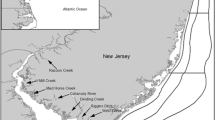Abstract
It is a truism that the distribution of a predator should reflect that of its potential prey, but this is not well established for marine plankton communities. Purcell (1981) found that many siphonophore species were selective feeders and that one, Hippopodius hippopus, fed exclusively on ostracods. Pugh (1986) speculated that if such a dietary specificity also applied to other hippopodiid species, then a distributional relation between them and ostracods might be expected. This premise is examined using data from ‘Discovery’ stations in the N.E. Atlantic Ocean. A clear relation is found between the abundance of ostracods and hippopodiids, while copepods have a better relation with other calycophoran siphonophores.
Similar content being viewed by others
References
Angel, M. V., 1969. Planktonic ostracods from the Canary Island region; their depth distributions, diurnal migrations and community organization. J. mar. biol. Ass. U.K. 49: 515–553.
Angel, M. V., 1979. Studies on Atlantic halocyprid ostracods: their vertical distributions and community structure in the central gyre region along latitude 30° N from off Africa to Bermuda. Prog. Oceanogr. 8: 3–124.
Baker, A. de C., M. R. Clarke & M. Harris, 1973. The N.I.O. combination net (RMT1 + 8) and further developments of rectangular midwater trawls. J. mar. biol. Ass. U.K. 53: 167–184.
Fasham, M. J. R. & M. V. Angel, 1975. The relationship of the zoogeographic distributions of the planktonic ostracods in the North-east Atlantic to the water masses. J. mar. biol. Ass. U.K. 55: 739–757.
Gooday, A. J. & A. Moguilevsky, 1975. The sinking velocities of some halocyprid ostracods. J. exp. mar. Biol. Ecol. 19: 105–116.
Greene, C. H., 1985. Planktivore functional groups and patterns of prey selection in pelagic communities. J. Plankton Res. 7: 35–40.
Isaacs, J. D., 1977. The life of the open sea. Nature, Lond. 267: 778–780.
Kirkpatrick, P. A. & P. R. Pugh, 1984. Siphonophores and velellids. Linnean Society Synopses of the British Fauna (New Series) 29, 154 pp.
Lochhead, J. H., 1968. The feeding and swimming of Conchoecia (Crustacea, Ostracoda). Biol. Bull. 134: 456–464.
Mackie, G. O. & D. A. Boag, 1963. Fishing, feeding and digestion in siphonophores. Pubbl. Staz. zool. Napoli 33: 178–196.
Mackie, G. O., P. R. Pugh & J. E. Purcell, 1987. Siphonophore biology. Adv. mar. Biol. 24: 97–262.
Madin, L. P., 1988. Feeding behaviour of tentaculate predators: in situ observations and a conceptual model. Bull. mar. Sci. 43: 413–429.
Pugh, P. R., 1977. Some observations on the vertical migration and geographical distribution of siphonophores in the warm waters of the North Atlantic Ocean. In Proceedings of the symposium on warm water zooplankton. National Institute of Oceanography, Goa, India: 362–378.
Pugh, P. R., 1984. The diel migrations and distributions within a mesopelagic community in the Northeast Atlantic. 7. Siphonophores. Prog. Oceanogr. 13: 461–489.
Pugh, P. R., 1986. Trophic factors affecting the distribution of siphonophores in the North Atlantic Ocean. In A. C. Pierrot-Bults, S. van der Spoel, B. Zahuranec & R. K. Johnson (eds), Pelagic Biogeography, UNESCO, Paris: 230–234. (UNESCO Tech. Pap. mar. Sci. No. 49).
Purcell, J. E., 1981. Dietary composition and diel feeding patterns of epipelagic siphonophores Mar. Biol. 65: 83–90.
Purcell, J. E., 1984. The function of nematocysts in prey capture by epipelagic siphonophores (Coelenterata, Hydrozoa). Biol. Bull. 166: 310–327.
Totton, A. K., 1965. A Synopsis of the Siphonophora. Brit. Mus. (Nat. Hist.), London, 230 pp.
Author information
Authors and Affiliations
Rights and permissions
About this article
Cite this article
Pugh, P.R. Co-occurrence of hippopodiid siphonophores and their potential prey. Hydrobiologia 216, 327–334 (1991). https://doi.org/10.1007/BF00026482
Issue Date:
DOI: https://doi.org/10.1007/BF00026482




